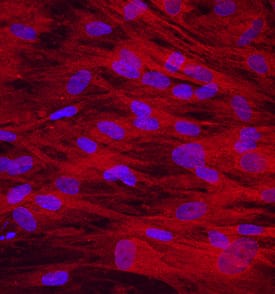Human Osteoadherin/OSAD Antibody
R&D Systems, part of Bio-Techne | Catalog # MAB2884

Key Product Details
Species Reactivity
Applications
Label
Antibody Source
Product Specifications
Immunogen
Gln21-Gln421
Accession # Q99983
Specificity
Clonality
Host
Isotype
Scientific Data Images for Human Osteoadherin/OSAD Antibody
Osteoadherin/OSAD in Human Mesenchymal Stem Cells.
Osteoadherin/OSAD was detected in immersion fixed human mesenchymal stem cells differentiated into osteocytes using Mouse Anti-Human Osteoadherin/OSAD Monoclonal Antibody (Catalog # MAB2884) at 10 µg/mL for 3 hours at room temperature. Cells were stained using the NorthernLights™ 557-conjugated Anti-Mouse IgG Secondary Antibody (red; Catalog # NL007) and counterstained with DAPI (blue). Specific staining was localized to cytoplasm. View our protocol for Fluorescent ICC Staining of Stem Cells on Coverslips.Applications for Human Osteoadherin/OSAD Antibody
Immunocytochemistry
Sample: Immersion fixed human mesenchymal stem cells differentiated into osteocytes
Reviewed Applications
Read 1 review rated 5 using MAB2884 in the following applications:
Formulation, Preparation, and Storage
Purification
Reconstitution
Formulation
Shipping
Stability & Storage
- 12 months from date of receipt, -20 to -70 °C as supplied.
- 1 month, 2 to 8 °C under sterile conditions after reconstitution.
- 6 months, -20 to -70 °C under sterile conditions after reconstitution.
Background: Osteoadherin/OSAD
Osteoadherin (OSAD), also known as Osteomodulin, is an extracellular matrix keratan sulfate proteoglycan that belongs to the class II subfamily of small leucine-rich proteoglycans (SLRP). LRR motifs consist of approximately 20‑30 amino acids (aa) with conserved leucine spacing, folded into a structure with one beta-sheet and one alpha-helix (1, 2). The human OSAD cDNA encodes a 421 aa precursor that contains a 20 aa signal sequence and eleven tandem leucine rich repeats (3). Human OSAD shares 80‑84% aa sequence identity with bovine, mouse, and rat OSAD. Human OSAD shares 32‑35% aa sequence identity with human class II SLRPs Fibromodulin, Keratocan, Lumican, and PRELP. Bovine, mouse, and rat OSAD are expressed as 60‑85 kDa molecules, although the amino acid sequence for each predicts a size of 46‑47 kDa. The primary difference is due to the presence of extensive N-linked glycosylation that can also vary between tissues of the same species (4, 5). Human OSAD is expressed as an even larger 110 kDa molecule in teeth (6). OSAD contains eight sulfated tyrosine residues (4, 7) and is distinguished from other class II SLRPs by the presence of an approximately 70 aa C-terminal acidic domain (3). OSAD is expressed by fetal and adult osteoblasts but is not detectable in cartilage or tendon (3, 4, 8). In dental tissue, OSAD is expressed by odontoblasts and ameloblasts (5, 9‑11) and is involved in the mineralization of bone and teeth (5, 11, 12). OSAD promotes the adhesion of osteoblasts and odontoblasts to the surrounding matrix, an interaction that is mediated by Integrin alphaV beta3 (4, 6).
References
- Matsushima, N. et al. (2000) Proteins 38:210.
- Kobe, B. and A.V. Kajava (2001) Curr. Opin. Struct. Biol. 11:725.
- Sommarin, Y. et al. (1998) J. Biol. Chem. 273:16723.
- Wendel, M. et al. (1998) J. Cell Biol. 141:839.
- Hultenby, P.U. et al. (2003) Eur. J. Oral Sci. 111:128.
- Lucchini, M. et al. (2004) J. Dent. Res. 83:552.
- Onnerfjord, P. et al. (2004) J. Biol. Chem. 279:26
- Shen, Z. et al. (1999) Matrix Biol. 18:533.
- Buchaille, R. et al. (2000) Bone 27:265.
- Buchaille, R. et al. (2000) Matrix Biol. 19:421.
- Couble, M.L. et al. (2004) Histochem. Cell Biol. 121:47.
- Ramstad, V.E. et al. (2003) Calcif. Tissue Int. 72:57.
Alternate Names
Entrez Gene IDs
Gene Symbol
UniProt
Additional Osteoadherin/OSAD Products
Product Documents for Human Osteoadherin/OSAD Antibody
Product Specific Notices for Human Osteoadherin/OSAD Antibody
For research use only
